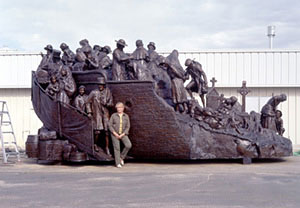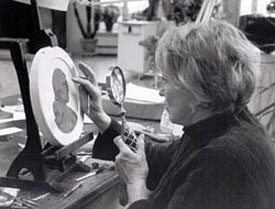Glenna Goodacre: Sculpting American History
 Glenna Goodacre with the Irish Memorial bronze at the foundry, 2002.
Glenna Goodacre with the Irish Memorial bronze at the foundry, 2002.Photograph by Marcia Ward, Image Maker
Known as one of America's most iconic artists, Glenna Goodacre didn't always know she'd become a sculptor.
"At the age of 19, I allowed a college sculpture professor to convince me I should never attempt sculpture," reveals Goodacre, who "He insisted I could not see in 3-dimensional form and gave me an unsatisfactory grade. This motivated me to draw and learn basic proportions and anatomy over the next ten years."
She went on to graduate from Colorado College and studied at the Art Students' League in New York before becoming a successful Texas portrait painter. After raising two children, Goodacre turned to sculpture. She gained notoriety for her bronze portrait busts of such well-known Americans as Dwight D. Eisenhower, Barbara Jordan, Katherine Anne Porter, Scott Joplin and Greer Garson. She also produced 7 1/2-foot standing bronze portraits of Ronald Reagan for the National Cowboy Hall of Fame in Oklahoma City and the Reagan Presidential Library in Los Angeles.
"I have always been totally absorbed with the figure and the head, the representation of emotion with body language and facial expression," Goodacre confesses. "I'm a figurative sculptor and I work in a realistic manner."
Her famous Washington, D.C. public tribute to 11,000 American military women who served during the Vietnam War led to her selection, in 1997, as sculptor for the bronze Irish Memorial in Philadelphia. Installed at Penn's landing on the Delaware River where many Irish immigrants originally disembarked, the monument displays a dynamic arc filled with movement, is 12' high, 30' long and 12' wide and contains 35 life-size bronze figures. The east end shows the darkest days, the misery of starvation during the famine in Ireland and its people leaving for America. The higher end tilts west and captures their hope-filled arrival as they step onto American shores. Constructed in clay with a resilient silicone bronze covering, the dark patina containing a touch of green has grown deeper over the years.
Goodacre uses similar techniques for much of her sculpture.
 Glenna Goodacre in her studio doing the relief sculpture original for the Sacagawea Dollar.
Glenna Goodacre in her studio doing the relief sculpture original for the Sacagawea Dollar.Photograph by Doug Merriam
"I do some drawing but most of the time I'll do a small sketch in clay," she says." For the Irish Famine Memorial, I did several maquettes with 6" tall figures. I used specific models for the Vietnam Women's Memorial - a nurse I'd known for years and three different models for the soldier."
When Goodacre read in the newspaper that the U.S. Mint had chosen Sacagawea as subject for the front of a coin to replace the Susan B. Anthony dollar, she began designing. In addition to specifications by the Dollar Coin Act, the Secretary of the Treasury required that the obverse must depict one or more women, but not a living person. Also, the coin needed to possess similar metallic, anti-counterfeiting properties as current circulating U.S. coins. The image had to be clearly visible but not touching the edge of the coin or border inscription.
There were no actual pictures of Sacagawea, who lived from 1788-1812, but Goodacre had read about the large dark eyes attributed to her in Shoshone legends. To replicate those features, she used a present day Shoshone college student, Randy 'L Teton, in authentic period beaded-leather dress, as her model.
"Goodacre did quick sketches, then created bas reliefs," recalls her Manager, Dan Anthony. "I put lettering on them, photographed them and submitted photographs to the U.S. Mint for the competition."
The competition was narrowed down to three designs, all by Goodacre. One showed Sacagawea pointing the way, looking off in the distance. But the selected image portrays her staring straight at the beholder. Because she was six months pregnant when she joined the Lewis and Clark Expedition as interpreter/guide and gave birth early in the journey, the design features Sacagawea carrying her infant son, Jean Baptiste, on her back. "I wanted people to be moved by her youth, strength and intensity," Goodacre says, "to create what truly means something emotionally to people."
In 1999, Goodacre's rendering of the face was unveiled at the White House by Hillary Rodham Clinton.
 Glenna Goodacre, one of her preliminary designs and her model for the figure of Sacagawea on the coin, Randy L' Teton, a Shoshone-Bannock college student.
Glenna Goodacre, one of her preliminary designs and her model for the figure of Sacagawea on the coin, Randy L' Teton, a Shoshone-Bannock college student.Photograph by Doug Merriam
Goodacre was pleased that she actually sculpted the final design before it was reduced for the dies. "The Sacagawea dollar is one of the few coins in history with a 3/4 profile head, I think the only one in U.S. history," she says. "It is also unique that it has an infant in 3/4 profile, making it doubly unusual. It was a real challenge to sculpt the bas relief and get it flat enough to pass the specs by the U.S. Mint for a coin. I had to resculpt it half a dozen times."
It was then slightly modified for minting. Unlike all other U.S. coins, the Sacagawea dollars are the first U.S. circulating coins designed by a woman. When the coin went into circulation in 2001, the artist remarked, "The result will be a Goodacre sculpture in everybody's pocket."
Pete Domenici, a senator at the time, sponsored the original bill for the gold-colored coin because it was to contain copper from his home state of New Mexico. The Sacagawea dollars feature distinguishing traits including their golden color, extra-wide border, smooth edges and specifically designed alloys. They weigh 8.1 grams, are 2 mm thick and 26.5 mm in diameter. The physical makeup is three-layer clad construction of pure copper sandwiched between and metallurgically bonded to outer layers of manganese brass.
"Historically, her design has many aspects never before seen on U.S. currency," says Dustin Belyeu, Director of Nedra Matteucci Galleries in Santa Fe, New Mexico, which held a huge showing of Goodacre's work in 2009. "She was the first artist allowed to sign her name (gg appears in the fold of John Baptiste's blanket) with a design and this adds an element of fine art to the coin. Sacagawea faces you directly. The image has more emotional depth and is more informal than most coins. The addition of Sacagawea's son, Jean Baptiste, created the first U.S. coin in mint history to depict a child. This artistic freedom marks a significant departure from the past history of U.S. coin designs."
At Goodacre's request, the U.S. Mint paid her for her work with 5,000 burnished planchets treated with a special anti-oxidant agent to preserve their highly lustrous, proof-like appearance. These were struck with higher than normal pressure by polished dies.
In May, 2011, Goodacre donated 17 items in a presentation box to the National Numismatic Collection at the Smithsonian National Museum of American History. The fired clay coins she created, the bronze bas reliefs, plaster studies and pencil drawings demonstrate the creative and technical challenges of the Sacagawea design from conception to completion and are an important part of American history. And, Goodacre is one of only a handful of private sector artists in history who have created an American coin.
A member of the National Academy of Design and a Fellow of the National Sculpture Society, Goodacre's works have garnished numerous awards during her extensive career. In 2005, a street in her home town of Lubbock, Texas, was named Glenna Goodacre Boulevard. The same year, 2005, she received the New Mexico Governor's Award for Excellence in the Arts. She has resided in Santa Fe, New Mexico, since 1983. Her sculptures can be found in numerous private, corporate, municipal, national and international collections.
Resources:
Also in this Issue:
- Glenna Goodacre: Sculpting American History
- Joycelyn Boudreaux: A Keeper of Copper
- Copper Collage: The Multidimensional Work of Nancy Scheinman
- Redsmith Studio: The Magic of Working with Copper
- Declaration of Independence Stone Copy on Copper
